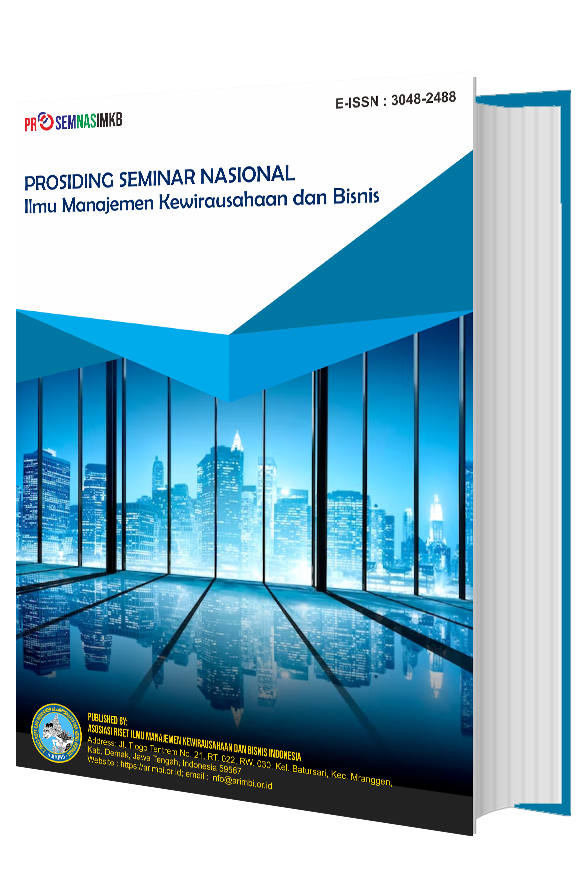Technology Acceptance Model (TAM) Untuk Mengukur Minat Adopsi Green Transportation Sepeda Motor Listrik di Kalimantan Barat
DOI:
https://doi.org/10.61132/prosemnasimkb.v2i2.212Keywords:
Adoption Intention, Electric Motorcycle, Green Transportation, Technology Acceptance Model, West KalimantanAbstract
Climate change and air pollution are necessitating a transition towards sustainable transportation. However, the adoption rate of electric motorcycles in West Kalimantan remains low. This study aims to analyze the factors shaping the intention to adopt electric motorcycles in this region using an extended Technology Acceptance Model (TAM) framework. A quantitative method was employed, involving a survey of 200 respondents selected through purposive sampling, with the data analyzed using Structural Equation Modeling (SEM). The results indicate that perceived usefulness and perceived ease of use have a positive and significant influence on adoption intention. Notably, perceived ease of use emerged as the most dominant determinant, not only directly impacting intention but also indirectly influencing it through perceived usefulness. Among the external variables, compatibility was found to enhance perceived usefulness, while enjoyment positively affected perceived ease of use. Conversely, resource availability did not significantly shape initial perceptions. The implications of these findings suggest that stakeholders should prioritize strategic communication that highlights the ease of use, enjoyable riding experience, and functional benefits of electric motorcycles. These efforts should be supported by policies aimed at accelerating infrastructure development and providing incentives to encourage broader adoption.
Downloads
References
Aguilar, J. J. C., Fernández, J. P., García, J. M. V., & Carrillo, J. A. C. (2017). Regenerative intelligent brake control for electric motorcycles. Energies, 10(10), 1648. https://doi.org/10.3390/en10101648
Ampriyadi, A., & Tafiprios, T. (2025). Analyzing factors affecting purchase intention of electric motorcycles in Jakarta City. The EUrASEANs: Journal on Global Socio-Economic Dynamics, 2(51), 402–412. https://doi.org/10.35678/2539-5645.2(51).2025.402-412
Ardila, F. C., Wibasuri, A., & Lestari, W. R. (2025). Traveloka booking technology and customer satisfaction at Hotel Sahid using TAM model. Jurnal Akuntansi, Keuangan, dan Manajemen, 6(2), 575–586. https://doi.org/10.35912/jakman.v6i2.4105
Bektaş, B. C., & Akyıldız Alçura, G. (2024). Understanding electric vehicle adoption in Türkiye: Analyzing user motivations through the technology acceptance model. Sustainability, 16(21), 9439. https://doi.org/10.3390/su16219439
Badan Pusat Statistik. (2023). Jumlah kendaraan bermotor menurut kabupaten/kota dan jenis kendaraan di Provinsi Kalimantan Barat (unit), 2023. BPS. https://kalbar.bps.go.id/en/statistics-table/3/VjJ3NGRGa3dkRk5MTlU1bVNFOTVVbmQyVURSTVFUMDkjMw==/jumlah-kendaraan-bermotor-menurut-kabupaten-kota-dan-jenis-kendaraan-di-provinsi-kalimantan-barat--2018.html?year=2023
Burton-Jones, A., & Hubona, G. S. (2006). The mediation of external variables in the technology acceptance model. Information & Management, 43(6), 706–717. https://doi.org/10.1016/j.im.2006.03.007
Butt, M. H., & Singh, J. G. (2023). Factors affecting electric vehicle acceptance, energy demand and CO₂ emissions in Pakistan. Green Energy and Intelligent Transportation, 2(3), 100081. https://doi.org/10.1016/j.geits.2023.100081
Campino, J., Mendes, F. P., & Rosa, Á. (2023). The race of ecological vehicles: Consumer behavior and generation impact in the Portuguese market. SN Business & Economics, 3(8), 1–30. https://doi.org/10.1007/s43546-023-00524-2
Chanda, R. C., Vafaei-Zadeh, A., Hanifah, H., Ashrafi, D. M., & Ahmed, T. (2024). Achieving a sustainable future by analyzing electric vehicle adoption in developing nations through an extended technology acceptance model. Sustainable Futures, 8, 100386. https://doi.org/10.1016/j.sftr.2024.100386
Conner, M., & Norman, P. (2022). Understanding the intention-behavior gap: The role of intention strength. Frontiers in Psychology, 13, 923464. https://doi.org/10.3389/fpsyg.2022.923464
Cox, B. L., & Mutel, C. L. (2018). The environmental and cost performance of current and future motorcycles. Applied Energy, 212, 1013–1024. https://doi.org/10.1016/j.apenergy.2017.12.100
Davis, F. D. (1989). Perceived usefulness, perceived ease of use, and user acceptance of information technology. MIS Quarterly, 13(3), 319–340. https://doi.org/10.2307/249008
Firdaus, Z. Y., Krisbiantoro, D., & Afiana, F. N. (2022). Analisis faktor-faktor yang mempengaruhi penerimaan dan penggunaan aplikasi dompet digital menggunakan technology acceptance model (TAM). Journal of Information System Management (JOISM), 3(2), 56–62. https://doi.org/10.24076/joism.2022v3i2.619
Hair, J. F., Babin, B. J., Anderson, R. E., & Black, W. C. (2010). Multivariate data analysis. Pearson.
Harmanta. (2024, December 29). Karena ramah lingkungan, motor listrik semakin diminati masyarakat. RRI. https://www.rri.co.id/pontianak/daerah/1222530/karena-ramah-lingkungan-motor-listrik-semakin-diminati-masyarakat
Hyginus, V., Eze, U., Saah, J., Ii, T., Mundu, M., Mustafa, M., George, A., Alaneme, U., Chidinma, E., Eze, E., Hassan, F., & Bawor, F. (2025). Navigating the road to sustainable mobility: Opportunities and challenges in electric vehicle adoption in Liberia. Discover Electronics, 2(1), 1–32. https://doi.org/10.1007/s44291-025-00058-x
Kadir, M. I., & Tricahyono, D. (2023). Analyzing Cyclops application acceptance in Telkomsel Pamasuka using IDT and TAM. Jurnal Bisnis dan Pemasaran Digital, 3(1), 21–40. https://doi.org/10.35912/jbpd.v3i1.4498
Katrin, A. (2024, June 6). Indonesia pacu penggunaan e-bike capai 4,5 juta unit. Siaran Indonesia. https://www.siaranindonesia.com/baca/20240606/indonesia-pacu-penggunaan-e-bike-capai-45-juta-unit.html
Lazuardy, A., Nurcahyo, R., Kristiningrum, E., Ma'aram, A., Farizal, Aqmarina, S. N., & Rajabi, M. F. (2024). Technological, environmental, economic, and regulation barriers to electric vehicle adoption: Evidence from Indonesia. World Electric Vehicle Journal, 15(9), 422. https://doi.org/10.3390/wevj15090422
Lee, D. Y., & Lehto, M. R. (2013). User acceptance of YouTube for procedural learning: An extension of the technology acceptance model. Computers & Education, 61(1), 193–208. https://doi.org/10.1016/j.compedu.2012.10.001
Liesa-Orús, M., Latorre-Cosculluela, C., Sierra-Sánchez, V., & Vázquez-Toledo, S. (2022). Links between ease of use, perceived usefulness and attitudes towards technology in older people in university: A structural equation modelling approach. Education and Information Technologies, 28(3), 2419–2438. https://doi.org/10.1007/s10639-022-11292-1
Ludin, D., Schreier, N., Mueller, E., Wellbrock, W., Melber, P., & Sollner, J. (2023). Acceptance of e-motorcycles: A longitudinal survey at Loewensteiner Platte, South Germany. World Electric Vehicle Journal, 14(12), 326. https://doi.org/10.3390/wevj14120326
Madan, A. (2023). Electric two wheelers growing fast in India: A summary of India’s electric two-wheeler market trends, opportunities and challenges. International Journal of Social Science & Economic Research, 8(9), 2767–2781. https://doi.org/10.46609/ijssen.2023.v08i09.019
Ngoc Su, D., Quy Nguyen-Phuoc, D., Thi Kim Tran, P., Van Nguyen, T., Trong Luu, T., & Pham, H. G. (2023). Identifying must-have factors and should-have factors affecting the adoption of electric motorcycles: A combined use of PLS-SEM and NCA approach. Travel Behaviour and Society, 33, 100633. https://doi.org/10.1016/j.tbs.2023.100633
Nordhoff, S., Louw, T., Innamaa, S., Lehtonen, E., Beuster, A., Torrao, G., Bjorvatn, A., Kessel, T., Malin, F., Happee, R., & Merat, N. (2020). Using the UTAUT2 model to explain public acceptance of conditionally automated (L3) cars: A questionnaire study among 9,118 car drivers from eight European countries. Transportation Research Part F: Traffic Psychology and Behaviour, 74, 280–297. https://doi.org/10.1016/j.trf.2020.07.015
Peraturan Presiden Nomor 55 Tahun 2019 tentang percepatan program kendaraan bermotor listrik berbasis baterai (Battery Electric Vehicle) untuk transportasi jalan. (2019). Lembaran Negara Republik Indonesia. https://peraturan.bpk.go.id/Details/116973/perpres-no-55-tahun-2019
Downloads
Published
How to Cite
Issue
Section
License
Copyright (c) 2025 Prosiding Seminar Nasional Ilmu Manajemen Kewirausahaan dan Bisnis

This work is licensed under a Creative Commons Attribution-ShareAlike 4.0 International License.






